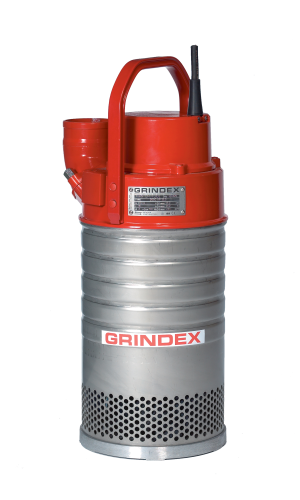
Different kind of construction sites contains various kinds of solids in the water. The type and concentration of the solids is normally the most important factor when choosing pump type:
• A drainage pump is the most commonly used pump type at construction sites. It is used for pumping water with less abrasive solids, like clay. Sand and solids in suspension can also be pumped, up to the size of the strainer holes (normally 7–12 mm). As sand is quite abrasive to the pump, it must not be too concentrated.
• Sludge pumps are suitable for pumping water with solids, as well as for pumping sludge. The solids can be up to the size of the pump inlet (normally 32–80 mm).
• Slurry pumps are designed to handle abrasive solids in suspension, like sand, gravel and concrete, in high concentration. To cope with the abrasives, the hydraulic parts of a slurry pump are often made of NiHard 4, one of the hardest materials available today. For improved performance, slurry pumps are generally equipped with an agitator.
Plug it in and pump
Electrical submersible pumps are easy to use, just plug it in and pump. This becomes handy when the work on a construction site goes on, and the number of pumps needed changes. The greatest need is normally after excavating of the holes for the foundation. Several small pumps, placed where the need is for the moment, can pump the water to a dedicated collecting pump pit through long hoses. As the smaller submersible pumps only weights 15–25 kg, a construction worker can carry the pump with him as he works on different spots at the site.
In the pump pit, a bigger pump is installed and pumps the water away from the site.
Make sure that the pump doesn't burrow itself into sand or clay. This can be done by letting the pump stand on a plank or a bed of coarse gravel. The pump can also be placed into a cut-down and perforated oil drum.
Application example
A typical example of successful dewatering of a construction site includes a road construction site. After a slope, right before the road was entering a tunnel, the site was located some 10 m below surface. Water came in both from the surrounding and through rain. Several Minex pumps, equipped with long 2 inch hoses, were spread evenly around the site. One Minex pump weighs 17 kg and delivers up to 12 l/sec. As the construction workers moved to a new spot at the site, they simply carried the pump with them and put it to work where it was needed. A dedicated pump pit was arranged with a Master N pump installed. A Master N pump delivers up to 55 l/sec. The water was pumped through a 4 inch hose to the ground level and into the street sewer.
Sedimentation
If the water contains sand, gravel or smaller stones, there might be necessary to use sedimentation tanks before pumping the water from the site. In the sedimentation tanks the solids will settle at the bottom and the water can be pumped on, to the sewer system or another location. The emptying of the solids can be simplified by using transportable containers for the tank systems. Pumping water from a construction site into a sewer system is often regulated by local laws.
Pump sizes
The portable pumps at a construction site are normally 1–2 kW, with a flow of 10–20 l/sec and weights 15–25 kg. The pump in the collecting pit is usually from 10 kW and up. If the water shall be pumped to a higher level, a more detailed calculation might be necessary. One big pump can, of course, be replaced by several smaller pumps.
By switching one or two smaller pumps on/off, the flow can be adjusted to match the inflow. This can be done by float switches that automatically switch the pump on and off as required by the water level in the pit. This saves both electricity and extends the service intervals at the pump.
Summary
Choose pump type after the different kind of solids in the water. Drainage pumps are most common
• Arrange with several small pumps evenly spread in the area that needs dewatering.
• Dedicate a collecting pump pit, with one big (or several smaller) pumps installed. These pumps may be automatically controlled by float switches.
• If the water shall be pumped to a street sewer, check the local laws for this matter first. The water might have to pass sedimentation tanks before leaving the construction site.
Dewatering a construction site is not very high tech, but needs to be done properly to avoid flooding.




